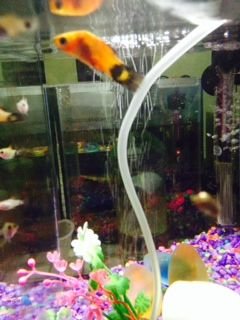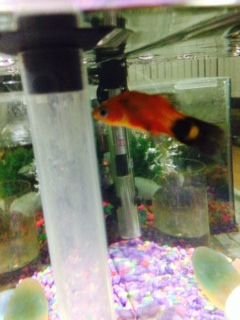If some platys look thin and one died of a bent spine I think you should treat for camallanus worms.
Levaimsole is a good medication for camallanos worms. It's a pig wormer.
Take a sample of your tank water to the local fish store and ask then to write the readings down for you.
Also improve there diet with frozen foods like brime shrimp, blood worms, daphnia.
More veg like broc, spinach, green cabbage, lettuce etc. Anything green really.
Camallanus
Symptoms:
When the fish is stationary, deep red worms can be seen protruding from the anal pore. They are only visible when the fish is still because the worms retreat into the intestine at the fish�s slightest movement. Other signs may include an inflamed and enlarged anus. In severe infestations, the fish may become emaciated and spinal curvature may also occur.
Cause:
The parasitic worms
Camallanus Cotti and
Camallanus lacustris. These small, livebearing parasitic worms attach to the intestinal walls and rectum with pinchers. The worm�s grip is so tight that any attempts to remove it forcibly will rip away tissue from the intestinal wall. The worm�s pinching causes ischemia (reduced blood flow) to that part of the intestine. In time, the tissue to that part of the intestine will die, at which time the worm will migrate to another part of the intestine. This causes perforations throughout the intestine, which allows other pathogens to gain entry. If the fish is not treated, either the parasite or bacterial will kill the fish. Camallanus infestations occur most often in livebearing fish such as Guppies and Mollies, though infection is possible in all fish. Camallanus infestations are contagious. All fish, including those not yet showing visible symptoms, as well as the aquarium, should be treated.
Treatment:
Treat with Internal Parasite Guard, Pipzine, Disco-Worm, Trichlorfon or Fluke-Tabs as well as a medicated food to prevent a bacterial infection.
Another link to camallanous worms.
http /www.fishchannel.com/fish-health/freshwater-conditions/camallanus-worms.aspx
/www.fishchannel.com/fish-health/freshwater-conditions/camallanus-worms.aspx








 /www.fishchannel.com/fish-health/freshwater-conditions/camallanus-worms.aspx
/www.fishchannel.com/fish-health/freshwater-conditions/camallanus-worms.aspx